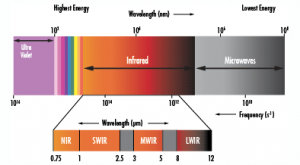 There’s an age old saying that tells us, “It’s what’s on the inside that counts” and while this saying may be true, it can often pose a problem: what if you’re unable to see what’s on the inside? Well, thanks to short-wave infrared (SWIR) imaging, we have your answer.
There’s an age old saying that tells us, “It’s what’s on the inside that counts” and while this saying may be true, it can often pose a problem: what if you’re unable to see what’s on the inside? Well, thanks to short-wave infrared (SWIR) imaging, we have your answer.
Much like the way visible light works, when it comes to these shorter wavelengths, photons are reflected or absorbed by the object in question. As a result of this absorption and reflection, it gives users a strong contrast which in turn allows for high resolution imaging -- something that can be useful in a variety of applications. From produce inspection and anti-counterfeiting, to surveillance, these applications are utilizing the benefits of SWIR imaging, but with one component being key: the lenses.
There are lenses created specifically for this short-wave infrared range of 0.9 -1.7 µm. Edmund Optics is one of the manufacturers out there creating these lenses. They create lenses that are designed and coated for this particular wavelength range. It should be noted though, that lenses used for the visible light spectrum can also be used, but they can result in lower resolution images.
Major differences between visible light and SWIR are the fact that SWIR imaging can see through water and fog and can also differentiate between colors that would typically look similar under other kinds of light.
Let’s look at an example: Say you’re looking at an apple using just your eyes. Due to normal, visible light, it could appear red, ripe, and like it’s going to taste delicious. However, if you looked at that same apple with SWIR imaging you’d be able to see any bruising or imperfections hiding beneath the surface.
It’s reasons like the one above that has made SWIR a viable solution for multiple scenarios and applications. Specifically in instances where looking at an image or object in visible light just isn’t clear enough, SWIR proves that when it comes to certain applications, there can always be more than what meets the eye.
